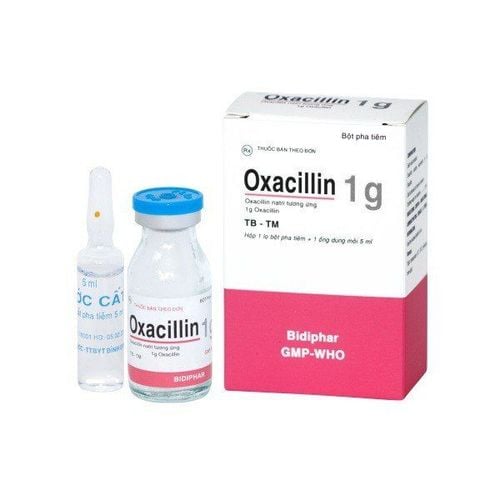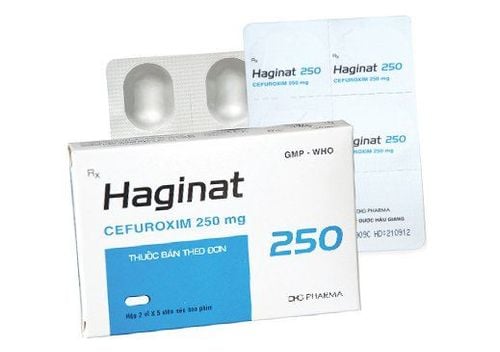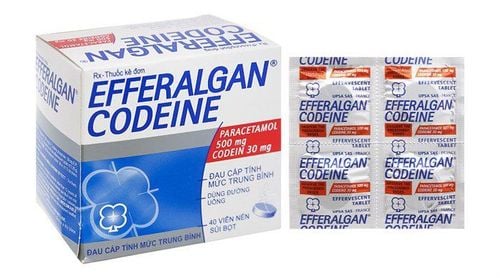This is an automatically translated article.
Cefacyxim is an antibiotic used by injection, belonging to the 3rd generation cephalosporin group. The drug is usually indicated for use in severe infections and to prevent the risk of infection after surgery.1. What is Cefacyxim?
Cefacyxim is an antibiotic with the main active ingredient being Cefotaxime Sodium 1g, prepared in the form of lyophilized powder for injection.
Cefotaxime is a 3rd generation, broad spectrum cephalosporin antibiotic.
Bacteria commonly susceptible to this antibiotic include Enterobacter, E.coli, Serratia, Shigella, Salmonella, P. mirabilis, P.vulgaris, Haemophilus influenzae, Haemophilus spp.,...
However, people also found that many types of bacteria are now resistant to this antibiotic. Therefore, to ensure the effective use of drugs should be used according to the results of the antibiogram.
Cefotaxime is administered by injection and is rapidly absorbed after injection. This drug is widely distributed in tissues and fluids. The drug concentration in the cerebrospinal fluid reaches a level that has a therapeutic effect, especially in meningitis, the drug concentration increases more. Cefotaxime crosses the placenta and is present in breast milk.
2. What are the effects of Cefacyxim?
Cefacyxim drug works to kill bacteria by inhibiting bacterial cell wall synthesis. This is a drug with strong antibacterial effect, broad-spectrum should only be used in severe infections, the drug is indicated in the following cases of sensitive bacterial infections:Sepsis, bone and joint infections, pericarditis caused by Gram-positive cocci and Gram-negative bacteria; bacterial meningitis. Skin and soft tissue infections; Intra-abdominal infections, gynecological and obstetric infections; Infections of the lower respiratory tract, urinary tract; Gonorrhea infection. Prophylaxis of postoperative infections.
3. Dosage and how to use Cefacyxim
How to use: Cefacyxim is used by intramuscular injection or intravenous infusion. The preparation of solution for infusion and infusion is carried out by medical personnel.
Dosage:
For adults: Uncomplicated infections use 1g/12 hours, intramuscularly or intravenously. Severe infections such as bacteremia, meningitis: 2g every 6-8 hours, intramuscularly or intravenously. Uncomplicated gonococcal infection, a single dose of 1g, intramuscularly. For urticaria with disseminated complications: 1g intravenously every 8 hours; continue taking cefotaxime for 24 - 48 hours after the disease has improved; can then be switched to oral antibiotics such as cefixime or cefpodoxime for at least a week for complete recovery. Prophylaxis of infection after surgery: Use 1g and inject 30 minutes before surgery. For children: Children 2 months or <12 years: Use at a dose of 50mg - 150mg/kg/day, divided into 3-4 times, intramuscularly or intravenously. Newborns > 7 days: Use 75 - 150mg/kg/day, divided into 3 times, intravenously. Premature infants and infants < 7 days: Use at a dose of 50mg/kg/day, divided into 2 times, intravenously. Renal impairment with creatinine clearance <10mL: Administer the usual loading dose, then reduce the maintenance dose by half. Use no more than 2g per day. Hepatic Impairment: No dose adjustment is required for patients with mild to moderate hepatic impairment, unless the patient has concomitant renal impairment. For severe liver disease, dose reduction is recommended.
4. Side effects of the drug Cefacyxim
In addition to the main treatment effect of this antibiotic, you may also experience some side effects such as:
Common: Diarrhea, vomiting, nausea; thrombophlebitis at the injection site; pain, induration and inflammatory reaction at the site of intramuscular injection; pruritus, rash. Uncommon: eosinophilia or decreased white blood cell count in general; positive Coombs test; can cause superinfection due to bacteria resistant to this drug such as Pseudomonas aeruginosa, Enterobacter spp,... headache; dizziness, lightheadedness and hallucinations; candidiasis, vaginitis. Rare: Anaphylaxis, other hypersensitivity reactions such as fever, skin hypersensitivity reactions; thrombocytopenia, agranulocytosis, hemolytic anemia; arrhythmia; pseudomembranous colitis or severe diarrhea caused by Clostridium difficile; increased serum bilirubin and liver enzymes. Any side effects that you think are caused by the drug should be reported to your doctor for appropriate treatment.
5. Things to pay attention to when taking Cefacyxim
Do not use Cefacyxim when the patient is allergic to Cefotaxime or other active ingredients in the drug; allergic to other antibiotics of the Cephalosporin group. Before initiating treatment with the antibiotic cefotaxime, the patient's history of allergy to cephalosporins, penicillins, or other drugs should be thoroughly investigated. Cross-allergic reactions between penicillins and cephalosporins occur in 5-10% of cases. Use extreme caution when administering the antibiotic cefotaxime to patients who are allergic to penicillin antibiotics. Long-term use of antibiotics can lead to fungal or bacterial superinfections, including diarrhea caused by Clostridium difficile infection and pseudomembranous colitis. The treatment plan must be changed accordingly. Use this drug with caution in patients with a history of convulsions; especially in patients with renal impairment who do not reduce the dose, due to the increased risk of convulsions. If convulsions occur during treatment with cefotaxime, the drug should be discontinued and anticonvulsant therapy indicated. If drugs that are potentially nephrotoxic (eg, aminoglycoside antibiotics) are used concurrently, renal function should be monitored regularly. The drug can cross the placenta, so it is not recommended for pregnant women. Used only if the infection is severe. Although only a small amount of the drug passes into breast milk, when a nursing mother takes the drug, it can affect 3 problems in the nursing infant: intestinal bacteria, testing when the baby is infected, antibiotic resistance. antibiotic. Use only when needed and monitor the response of the nursing infant. Drug interactions: Probenecid reduces drug elimination: Cephalosporins and colistin groups (polymyxin antibiotics) when used together can increase the risk of kidney damage; Cefotaxime when used can reduce the effectiveness of typhoid vaccine. In addition, some other drugs also cause interactions, you should talk to your doctor about the medicine you are taking. Cefacyxim antibiotics should only be used under the direction of a doctor and when severe infections do not respond to oral antibiotics. You need to inform your doctor about your history of allergies and adverse reactions when taking the drug.













